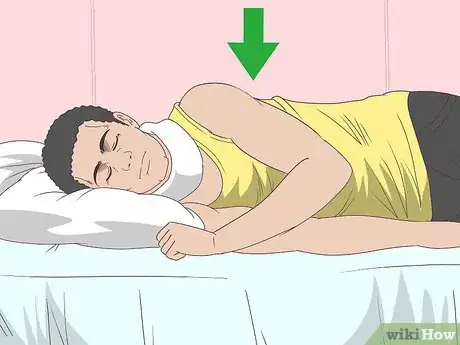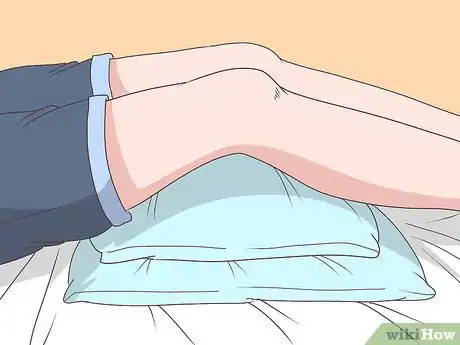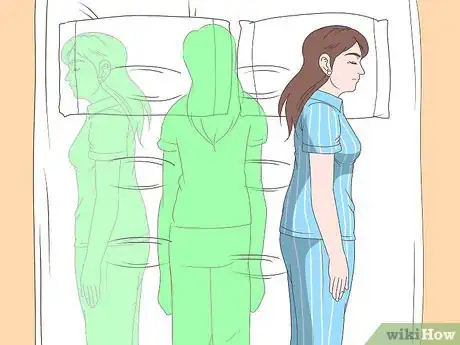This article was medically reviewed by Sarah Gehrke, RN, MS. Sarah Gehrke is a Registered Nurse and Licensed Massage Therapist in Texas. Sarah has over 10 years of experience teaching and practicing phlebotomy and intravenous (IV) therapy using physical, psychological, and emotional support. She received her Massage Therapist License from the Amarillo Massage Therapy Institute in 2008 and a M.S. in Nursing from the University of Phoenix in 2013.
wikiHow marks an article as reader-approved once it receives enough positive feedback. In this case, 91% of readers who voted found the article helpful, earning it our reader-approved status.
This article has been viewed 81,655 times.
Sleeping after you have had cervical neck surgery can be a challenge, as you will need to avoid putting strain on your neck, shoulders, or back. Sleep is a top priority post-surgery, as it allows your body to heal. Getting a good night’s rest after cervical neck surgery means picking a sleep position that is comfortable and safe. You should also use pillows and extra support when you sleep, and get in and out of bed correctly to minimize your pain and discomfort as you recover from surgery.
Steps
Getting in and Out of Bed
-
1Sit on the edge of the bed. Getting in bed must be done carefully, as you do not want to put your neck at risk of injury. Start by sitting down on the edge of the bed, about halfway down the bed. Put your feet firmly on the ground and keep your neck and back straight.[1]
-
2Lower yourself on your side, resting on your elbow. Slowly bend to one side and rest your weight on your elbow. Try to keep weight on your hips and feet as well so you are well supported.[2]Advertisement
-
3Roll over to your back or side. Carefully lift your feet up onto the bed as you roll over to your back or to one side, using your elbow to support you. Try to keep your neck and spine straight as you roll so you do not twist these areas.[3]
-
4Roll to one side to get out of bed. To get out of bed, tuck your arms at your sides and roll over to one side so you are at the edge of the bed. Then, prop yourself up on your elbow and place your feet on the ground as you slowly lift yourself up to sitting. Try to keep your neck and spine straight as you rise up. Put weight on your legs, rather than your hips or back, to get out of bed.[4]
- You may need someone to help you get in and out of bed, especially during the first few weeks of your recovery. Ask a friend, family member, partner, or caretaker to help you, as needed.
Selecting a Good Sleep Position
-
1Follow instructions if your doctor recommends a collar or brace. Your surgeon may have ordered you to wear a neck collar or brace. Follow the surgeon's guidelines for when to wear it. Some people may find it more comfortable to sleep or nap in a recliner, especially when the collar or brace is on.[5]
-
2Sleep on your back to protect your neck and spine. The best sleeping position post-surgery is on your back. Keep your head, neck, and hips aligned as you lie on your back so your body is well supported.[6]
- Some people find it more comfortable to bend their legs and place their feet flat on the bed when they are lying on their back.
-
3
-
4Place a pillow under your head for support. Make sure the pillow is not too flat or high, as you do not want your neck to sink below your shoulders or be at an angle up from your shoulders. Check that the pillow keeps your neck in line with your spine, rather than twisted to one side.[10]
- A pillow made out of foam can give your head and neck more support as you recover.
-
5Use a pillow between or under your legs for added comfort. If you are sleeping on your back, slide a pillow or a rolled up towel under your legs to better support your back. If you are sleeping on your side, you can put a pillow between your legs to support your back and chest.[11]
- If you tend to put your arms under your head or one knee up when you sleep on your side, place a pillow behind your back and hips to prevent rolling out of a side sleeping position.
-
6Keep your arms below your head and neck. Make sure your arms lay on either side of you or curled below your head and neck. This will ensure your neck and shoulders are not strained while you sleep.[12]
- You may find placing a heavy blanket over your body when you sleep can help to keep your arms from shifting or moving in the night.
Having a Good Night’s Sleep
-
1Create a cool, quiet sleep environment. Your bedroom should be comfortable and quiet so you can get a good night’s sleep. Make sure it is not too warm or bright, as a cooler, darker environment is usually best for sleeping.
-
2Have extra pillows and blankets within arm’s reach. If you tend to get cold during the night or like having extra pillows on hand, make sure they are easy for you to reach as needed. By the side of your bed or on a chair next to your bed is usually a good spot, as you will not need to move too much to reach them.
-
3Log roll to change sleep positions, as needed. If you want to switch from sleeping on your back to sleeping on your side, make sure you roll to change positions, supporting yourself on one elbow. Try to keep your neck, shoulders, and back straight as you roll so you do not strain these areas.[13]
-
4Take over-the-counter pain medication, if needed. Use ibuprofen or acetaminophen to help you manage any pain or soreness due to your neck surgery. Follow the instructions on the label and never take more than directed.
- If your pain is severe, your doctor may prescribe a stronger pain medication. Follow their instructions on dosage and do not take more than recommended.
References
- ↑ https://www.spineuniverse.com/treatments/surgery/cervical/cervical-spine-surgery-recovery
- ↑ https://www.spineuniverse.com/treatments/surgery/cervical/cervical-spine-surgery-recovery
- ↑ https://www.spineuniverse.com/treatments/surgery/cervical/cervical-spine-surgery-recovery
- ↑ https://www.spineuniverse.com/treatments/surgery/cervical/cervical-spine-surgery-recovery
- ↑ https://www.spine-health.com/treatment/spinal-fusion/1-2-weeks-after-acdf-surgery
- ↑ https://specialtysurgerycenter.org/best-sleeping-positions-after-surgery/
- ↑ https://www.hopkinsmedicine.org/orthopaedic-surgery/_documents/patient-information/patient-forms-guides/JHUCervSpineSurgeryGuide.pdf
- ↑ https://www.hopkinsmedicine.org/orthopaedic-surgery/_documents/patient-information/patient-forms-guides/JHUCervSpineSurgeryGuide.pdf
- ↑ https://www.spine-health.com/treatment/spinal-fusion/1-2-weeks-after-acdf-surgery
- ↑ https://www.youtube.com/watch?v=TyyzsjStVdk&feature=youtu.be&t=27
- ↑ https://specialtysurgerycenter.org/best-sleeping-positions-after-surgery/
- ↑ https://www.hopkinsmedicine.org/orthopaedic-surgery/_documents/patient-information/patient-forms-guides/JHUCervSpineSurgeryGuide.pdf
- ↑ https://www.hopkinsmedicine.org/orthopaedic-surgery/_documents/patient-information/patient-forms-guides/JHUCervSpineSurgeryGuide.pdf
About This Article
Sleeping after your cervical neck surgery can present a few challenges, but fortunately, with the right posture and careful movement, you can still enjoy a good night’s sleep. To get into bed, sit on the edge of the bed, lean slowly onto your side, then roll onto your back. To get out of bed, just do the reverse. It’s best to sleep on your back, since this puts the least strain on your neck and back, but you can also sleep on your side if you can’t get comfortable on your back. Use a firm pillow to keep your neck aligned with your body. You can also place another pillow between your legs to help support your back and chest. If you’re in a lot of pain, take a painkiller before bed as well. For more advice from our Medical co-author, including how to set up the perfect sleeping environment, read on.













































































Medical Disclaimer
The content of this article is not intended to be a substitute for professional medical advice, examination, diagnosis, or treatment. You should always contact your doctor or other qualified healthcare professional before starting, changing, or stopping any kind of health treatment.
Read More...